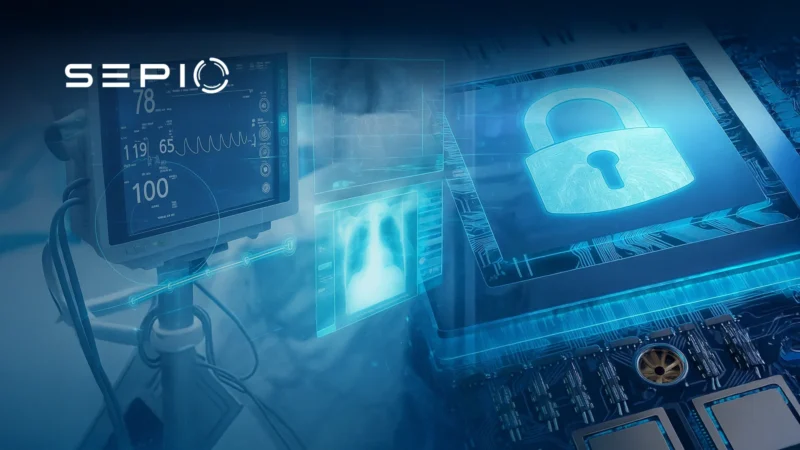Connected medical devices are essential to modern medical environments, enhancing patient care through real-time data sharing and remote monitoring. However, the rapid adoption of these IoT-enabled technologies has introduced significant security risks. The security of connected medical devices is now more critical than ever to ensure patient safety and protect sensitive healthcare data.
The security of connected medical devices is often compromised by cybercriminals exploiting vulnerabilities in these systems. These attacks can lead to data breaches, operational disruptions, and even put patients’ lives at risk. High-profile incidents, such as those targeting medical institutions in Ireland and Italy, highlight the urgent need for robust security measures.
Hospitals today operate an average of 10 to 15 connected medical devices per bed, significantly increasing the risk of cyber intrusions. A single cyberattack targeting these devices can disrupt operations, compromise data, and jeopardize lives, underscoring the importance of strengthening the security of connected medical devices.
The Growing Threat to Connected Healthcare Devices
Hackers increasingly target Healthcare Delivery Organizations (HDOs) due to the high value of personal information like Protected Health Information (PHI). On the dark web, a medical record can fetch up to $250, far exceeding the value of stolen credit card data. Unauthorized access to such data compromises patient safety and privacy.
Cyber-criminals exploit vulnerabilities in connected healthcare devices to manipulate or disable critical equipment. Such actions can harm patients directly, as malicious actors tamper with device functionality. Furthermore, the interconnected nature of healthcare information systems enables lateral movement, allowing bad actors to spread malware and gain control over entire networks.
Threat actors use diverse methods, such as hardware-based attacks, phishing schemes, and social engineering, to infiltrate healthcare systems. They may deploy spoofed peripherals or malicious devices into physical premises, further compromising the security of connected medical devices.
Identifying Security Gaps in IoT Healthcare Devices
Traditional security tools like NAC, EDS, and IoT security solutions fail to address physical layer vulnerabilities. This gap leaves healthcare organizations exposed to attacks that bypass existing defenses. Spoofed peripherals, for instance, can impersonate legitimate devices and evade detection, enabling attackers to:
- Security breaches through spoofed devices impersonating legitimate hardware.
- Data theft targeting sensitive information and encryption protocols.
- Launching ransomware or denial-of-service (DDoS) attacks that disrupt critical operations.
This leaves healthcare organizations vulnerable to cascading failures that impact compliance, safety, and patient outcomes.
As cyber threats continue to evolve, securing connected medical devices requires a proactive approach that extends beyond traditional security measures. These devices often operate on outdated software, lack built-in security features, and communicate across complex healthcare networks, making them attractive targets for cybercriminals. Implementing a Zero Trust framework, enforcing granular policy controls, and continuously monitoring device behavior are essential steps in mitigating risks. Without robust security measures, attackers can exploit vulnerabilities to disrupt critical healthcare services, compromise patient data, and even interfere with life-saving medical treatments.
Strengthening the Security of Connected Medical Devices in Healthcare
The security of connected medical devices must be a strategic priority. With the increasing use of these devices in diagnostics and treatment, the consequences of cyberattacks are becoming more severe.
Attackers often exploit outdated firmware and unsecured communications. Without proactive security policies, healthcare organizations risk data breaches, regulatory penalties, and reputational damage. Implementing Zero Trust architecture, comprehensive asset monitoring, and real-time threat mitigation can significantly improve resilience.
How Sepio Enhances the Security of Connected Medical Devices
Sepio’s platform offers a comprehensive solution to mitigate the risks associated with connected healthcare devices. By leveraging advanced asset visibility and Rogue Device Mitigation capabilities, Sepio enhances the security posture of Healthcare Delivery Organizations, with a specific focus on the security of connected medical devices and network protection.
Key features of Sepio’s solution include:
- Complete Asset Visibility: Creates a digital fingerprint for all IT, OT, and IoT devices.
- Policy Enforcement: Blocks unauthorized or rogue hardware in real-time.
- Threat Intelligence: Provides actionable insights for effective incident response.
Sepio addresses physical-layer security gaps, ensuring healthcare organizations are protected from advanced cyber threats, including ransomware, data breaches, and hardware-based attacks. This robust defense safeguards critical systems, ensures patient safety, and supports compliance with healthcare regulations.
Learn More About Healthcare Security and Connected Medical Devices
By implementing Sepio’s solution, healthcare organizations can secure their connected medical devices, protect sensitive data, and maintain uninterrupted operations amid evolving cyber threats.
Don’t let cyber threats compromise your healthcare systems and patient safety. Discover how Sepio’s advanced security solutions can protect your IoT medical devices from vulnerabilities and attacks. Take the first step toward securing your healthcare organization. Request a personalized demo today and discover how our solutions can secure your healthcare organization’s critical systems.






